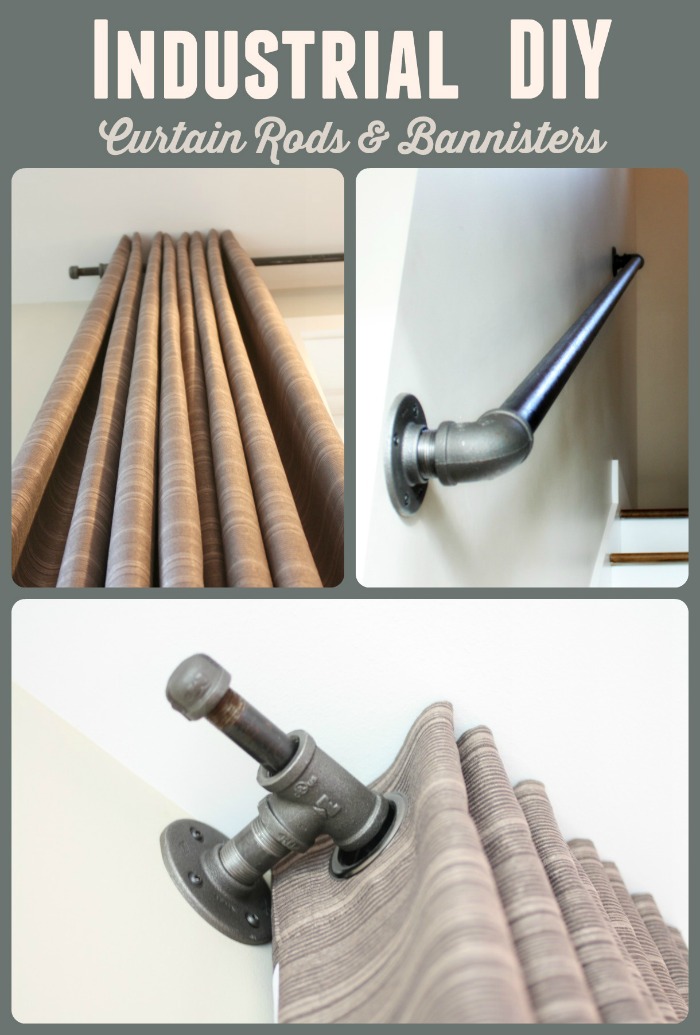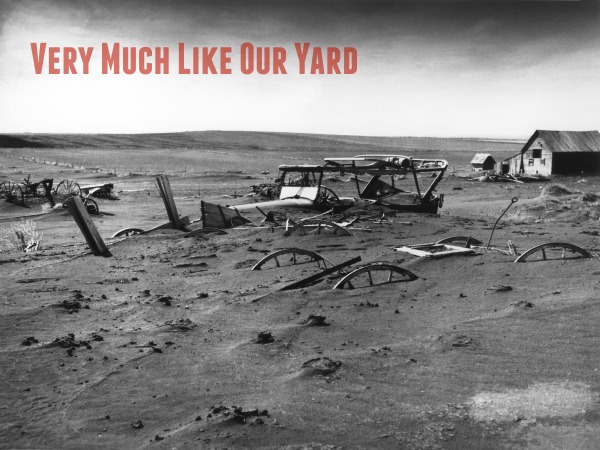
In Part I of this series, you got a glimpse of how Brianna and I transformed our bare bones bathrooms with fixtures constructed out of black iron pipe. Here in Part II we’ll take you further into our home and show you how you can use these same fittings to construct both standard and extra-long curtain rods throughout your/our living room.
Standard Length Curtain Rods
Curtain rods are never hard to find in a big box store. They are typically offered in 10-25 different styles for anywhere from $5 to $50. For most, people can find what they’re looking for in these venues. But not us. No, we can’t be that simple. We wanted something to match what was in our minds, and what we saw on the market just wasn’t doing it for us. And neither were the prices. A minimum of $25 per rod for something “substantial” isn’t cheap, and that wasn’t going to cut it for our limited “we just moved into a new house and have nothing” budget. It was at this point that we decided to pull the theme from upstairs down. Bring on the black iron pipe and fittings!
First we had to construct two standard length curtain rods for the windows on either side of the fireplace. I came up with a simple design and mounting system, got Brianna’s approval (the most important step of any project), then ordered my supplies.
Supplies
- 2 – 3/4″ Black Iron Floor Flanges*
- 2 – 2″ x 3/4″ Welded Steel Nipple*
- 2 – 3/4″ Black Iron Tee*
- 2 – 1/2″ Black Pipe Cap*
- 1 – 28″ x 1/2″ Black Iron Pipe (Note: this length should be determined halfway through installation. Don’t try to do it ahead of time. Trust me.)
Assembly and Installation
Yes, my supply list is right; I am going to use 1/2″ gauge pipe with 3/4″ pipe fittings. How?! Why?! Keep reading….
Step 1: Build and Mount your Brackets
This part is easy. (Actually the whole thing is easy. And cheap.)
- Connect a nipple to a flange.
- Connect a tee to the other side of the nipple.
- Hand-tighten everything
- Mount the bracket you just hand crafted (go you!) to the wall at a level you see fit.
To mount, we used bronze/black square head screws to complete the industrial look. Try to find a stud if you can, or use appropriate drywall anchors to ensure a snug, secure fit. Make sure the tee runs horizontal to the floor; miss this step, and well, you’ll have a great towel holder that’s just out of reach for your guests. If you end up here you should be able to tighten or loosen things just enough to get you back to good.
Step 2: Determine the Length of your Rod
Yes, you could have done this earlier, but trust me, you’ll be much happier with the end result if you wait until now to measure the length of pipe you’ll need to complete your curtain rod. Measure the distance between the outside edges of your tees. To that distance, add an absolute minimum of 3″ so that your pipe can overhang and be capped. For our installations, we added 6″ total giving us 3″ of overhang on each end.
Step 3: Slide your Rod into the Holes
Slide your length of 1/2″ rod into your 3/4″ tee. The 1/2″ rod will fit easily through the tee and allow for easy adjustment back and forth while you to get your curtain(s) in place. Now do you see why we went with 1/2′ pipe?
To install your curtains, insert one side of your rod into an open tee, slide your curtain onto the rod, and then pull the pipe back into place so that it rests in the unoccupied tee. When complete, install the pipe caps on either end, and voila!
Total cost per standard rod: $11.67
Extra-Long Curtain Rods
We’ve always loved the idea of being able to completely transform a room’s feel and appearance as day turned to night. The front wall of our home has two tall windows whose total span (windows and wallspace) covers more than 12′. After some convincing, Brianna sold me on the idea of floor to ceiling curtains that would span the entire wall. Here’s a preview:
During the day we’d let the light shine in. At night, we’d close the curtains and have a wall of fabric. However, to make this happen, we needed to find a 12′-long curtain rod. After a bit of searching, we weren’t coming up with anything for less than $120. Time to build our own!
Supplies
- 3 – 3/4″ Black Iron Floor Flanges*
- 3 – 2″ x 3/4″ Welded Steel Nipple*
- 2 – 3/4″ Black Iron Tee*
- 1 – 1/2″ x 1/2″ x 3/4″ Black Iron Reducing Tee*
- 2 – 1/2″ Black Pipe Cap
- 2 – 68″ x 1/2″ Black Iron Pipe
Assembly and Installation
This project follows the standard rod build instructions for the most part, but has a twist in the middle. Here goes:
Step 1: Build and Mount your Outside Brackets
- Connect a nipple to a flange.
- Connect a 3/4″ tee to the other side of the nipple.
- Hand-tighten everything
- Mount the brackets you just hand crafted to the wall at a level you see fit.
Use the same screws as before, and again, make sure the tee runs horizontal to the floor.
Step 2: Build and Mount your Inside Bracket
- Connect a nipple to a flange.
- Connect the special 3/4″ x 1/2″ x 1/2″ tee to the other side of the nipple.
- Hand-tighten everything
- Mount this bracket centered between the two mounts you’ve already installed. Same height. Still horizontal to the floor.
Step 3: Determine the Length of your Rods
Measure the distance between the outside edges of your tees to the close edge of the center support tee. To that distance, add an absolute minimum of 2″ so that your pipe can overhang and be capped. For our installations, we added 4″ total giving us 3″ of overhang on each end and 1″ to screw into the center tee.
Step 4: Slide your Rods into their Holes
Slide a length of 1/2″ pipe into your 3/4″ tee. Again, the 1/2″ rod will fit easily through the tee and allow for easy adjustment back and forth while you to get your curtain(s) in place. When your curtain on and ready to go, slide the rod back towards the center support and screw the 1/2″ pipe into the 1/2″ tee opening. Repeat for the other side of your new, nearly complete extra-long curtain rod. And oh yeah, cap the ends when complete!
Total cost for the extra-long curtain rod: $25.05
The Completed Whole-Room Look
Coming up in Part III
In Part III we’ll take you upstairs and show you how we’ve continued our theme in our stairwell by swapping out the existing construction-grade banisters and creating our own. This pop of style is both eye catching, functional, and can handle anything our four boys can throw at it!


















